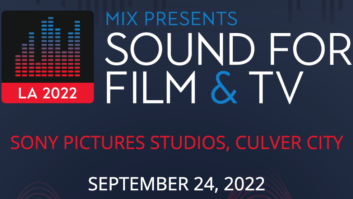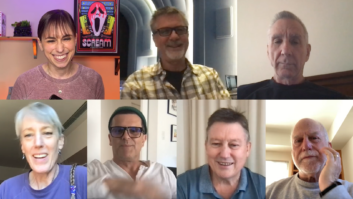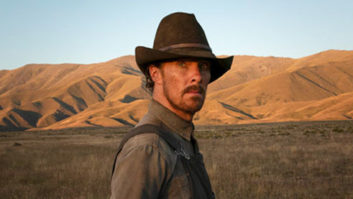I’m currently mixing a new ABC dramatic series called Wonderland about Bellevue psychiatric hospital. As you can imagine, it’s a madhouse. There’s tons of ad-libbing. Everything is shot with two cameras mounted on bungee cords (frame line?). Both cameras wander (“Well, I might do a two-shot of this dialog or I might bounce over and grab a three-shot of the dialog going on in the next room.”). Frequently, there will be simultaneous dialog going on in different rooms, and all the sets have rooms within rooms within rooms, all with glass walls, fixed ceilings and walls that don’t fly. When I viewed the pilot of the show, I quickly realized that none of the rules apply! So, after reading Larry Blake’s “An Open Letter to Production Mixers” on these very pages, I determined that my first step should be a visit to post. I was very fortunate. Post was here in New York instead of L.A., a post supervisor had already been hired and a sound team had been lined up (although it had not yet started).
We each made a first mistake. I tried to convince post that the show should be done multitrack with either a Deva or a Nagra D. I would deliver a mono mix on one channel and either a second mix or solo’d mics on the other three tracks, depending on the individual shot. For instance, if camera A was doing a wide master, then the mix would be fine. If camera B was doing roving close-ups then the solo’d radio mics on the additional channels would come in very handy if the mix sounded too wide.
Post’s first mistake was to turn down this option. They wanted a DAT with split tracks.
My first mistake was to go along. I should have done what I felt was best and gone multitrack and forced post into dealing with it.
Here’s why.Doing a simultaneous mix for the sound editor and for dailies (and the picture editors) is like a concert mixer doing a simultaneous mix for the P.A. and for the CD. They are two different beasts. Years ago, after being in a similar circumstance, I swore off ever splitting tracks on an episodic and always supplying a mono mix and nothing more. Because of the complexity of the show and since the sound editor requested it, I broke my rule and supplied split tracks. Initially, I suggested doing a mono mix on one channel and putting whatever mic might be of most assistance in post on the second channel, but after a week of production, the word came down to mix as little as possible and split the tracks.
What does this mean? If it were a simple show and I averaged two mics per scene, this would be very easy. Two people walk and talk, two radio mics, two channels, no sweat. On Wonderland, however, I average four to six mics on every shot. There are always two booms and often a plant and a few radios. There’s no logical plan for splitting the mics that works scene in and scene out. I have to come up with a scheme for each shot, depending on the specifics of that shot (and since much of the dialog is ad-libbed and the bungeecam shots are flexible, to say the least, the specifics are hard to pin down).
Sometimes I’ll mix two booms on one channel and three radios on the other. Sometimes it will be a boom and radio on each of the channels. I monitor in stereo and it sounds great, but here’s where the problems start.
Problem One: The on-set Comtek wireless headset feeds to the boom people, director, producer, script, visiting dignitaries, etc. It’s a mono feed summing my two tracks together. It sounds horrible. When the two tracks are summed, you get phase cancellation. I have two Comtek transmitters, so I can give the main boom person his own mic solo’d, but everyone else gets a mono mix. I’m amazed I haven’t been fired yet.
It’s not just an aesthetic problem. Directors will do additional takes because, for instance, they heard a problem on the RF mic while the part of the scene in question was on the boom on a different track.
Problem Two: Whatever problems we have on set with the headsets being summed to mono are multiplied in the picture editing suite. The sound goes through many processes. It’s transferred to Digi Beta; simul-DATs are made. It’s transferred to analog video. It’s digitized into the Avid and eventually reconformed. Not having one mono track has led to problems at every stage. I’ve gotten calls from post: “We have a close-up of so-and-so, and she’s way off mic.” My first thought is that the “B” camera swung over and got a shot of someone I thought was off-camera, or maybe someone ad-libbed a line. But no, it was a key character’s close-up in a major scene. So the night before Thanksgiving, I drive an hour back into the city after wrap to meet with the editors.
Sure enough, we have our guest star Tovah Feldshuh and no sound. Okay, let’s check the originals. “That can’t be done. They’re in the vault at the lab.” Okay, let’s check both tracks on the Avid. There are two tracks there, but they are identical. Okay, let’s check the Digi Beta. We put that up and the sound is perfect. I give the headphones to the editors, and the sound is perfect. As it turns out, someone was deciding not to digitize both tracks at all times to save hard-drive space.
Relief? Not yet. Monday, after the holiday break, I get another call from post. “The sound is gone again…Yes, we know it sounded fine off the headphones, but when we put it through the Avid, she’s off mic again. WHAT DID YOU DO?” Oh boy, what did I do? My suspicion is that something is out of phase in the Avid system, but between problems in the initial transfer, problems in digitizing, hardware phase anomalies in the system and the fact that the sound editors are still not hired because the air date for the show has been pushed back to March, the split-track idea has turned into a nightmare for me and the picture editors. Although, in the end, if I survive that long, it will be a great help to the sound editors. Long after I’m fired, someone will be sitting in the final mix saying, “Why did we fire that guy? His tracks are pretty good.”
The point is that the location mixers are between a rock and a hard place. I’m leaning more and more toward multitrack as the solution. And on this show, four tracks might not be enough. I would consider using a DA-88-type machine and delivering a mono mix for dailies and solo’d mics for the sound editors, so they could remix any of the scenes if they didn’t like my mix. This is a drastic solution. But the more we see multicamera shoots as the norm, with ad-libbed dialog on stages that aren’t really stages, sets with fixed ceilings and cameras mounted on big rubber bands, the more we are forced into using multiple mics per scene. We can either mix them all to mono and deliver one track for better or worse, or solo them as if we were rock ‘n’ roll concert mixers and let you mix it later. Or we could do both so you can use our mix when it’s good and remix it when it’s not.
While better communications between production and post is a great help, I would suggest that sound editors plan to spend a day on the set both to see what we are facing and to give input when we make a decision on how to handle a certain shot. I’ve been in the business for more than 20 years, and the only time I saw a sound editor on-set was when he came to visit his girlfriend. Producers, please, add an extra day to the sound team’s schedule to pay for this. (Hey, wait a minute, come to think of it, I wasn’t paid for my two meetings with post.)
And finally, two shameless plugs. I’ve been doing this show with the new Zaxcom Cameo digital mixer. It’s a godsend. It’s very fast, very flexible, quiet and immune to RF. I’m very happy with it. And also, my Audio Ltd. RF mics have made this a totally wireless show. A few days ago, we did a scene that takes place at a comedy club. There’s a comedian onstage and two people speaking at a table. At the end of the scene, the comedian insults the guy’s wife, and he comes onstage and pummels the comedian. I wanted to give the comedian a live mic (an Audio Ltd. “HX” Schoeps transmitter with a Schoeps omni head), so I spoke to the actor, the stunt coordinator and the director, all of whom were enthusiastic about the live mic and swore to me that it wouldn’t be damaged in the brawl (stop snickering). At the last second, the comedian asked whether the mic could be live through the house P.A. system so the audience could hear and respond to him. With the Cameo board it took two mouse clicks to route the hand mic to an aux out (without also sending the other dialog mics), which I sent via a radio to the house board. I could separately control the output level of that aux, so I could ride the house P.A. level. The audience could hear and I could get a nice full tone on the hand mic for the recording.
And, of course, everyone lied. The mic got trashed, banged, dropped and, at one point, put where a microphone should never, ever go (it became a rather graphic prop), but it worked perfectly. Kudos to Schoeps, Audio Ltd. and Zaxcom. As hard as our job is, it would be a lot harder if we didn’t have high-quality equipment that worked day in and day out in spite of the abuse we give it.







